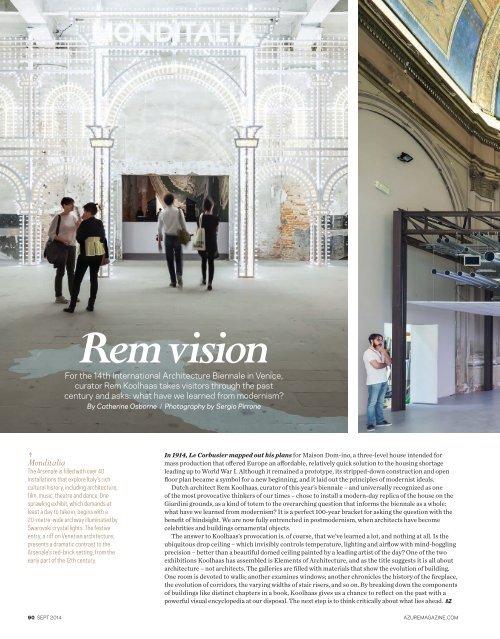AZURE_2014_09.pdf
You also want an ePaper? Increase the reach of your titles
YUMPU automatically turns print PDFs into web optimized ePapers that Google loves.
Rem vision<br />
For the 14th International Architecture Biennale in Venice,<br />
curator Rem Koolhaas takes visitors through the past<br />
century and asks: what have we learned from modernism?<br />
By Catherine Osborne / Photography by Sergio Pirrone<br />
↑<br />
Monditalia<br />
The Arsenale is filled with over 40<br />
installations that explore Italy’s rich<br />
cultural history, including architecture,<br />
film, music, theatre and dance. One<br />
sprawling exhibit, which demands at<br />
least a day to take in, begins with a<br />
20-metre-wide archway illuminated by<br />
Swarovski crystal lights. The festive<br />
entry, a riff on Venetian architecture,<br />
presents a dramatic contrast to the<br />
Arsenale’s red-brick setting, from the<br />
early part of the 12th century.<br />
In 1914, Le Corbusier mapped out his plans for Maison Dom-ino, a three-level house intended for<br />
mass production that offered Europe an affordable, relatively quick solution to the housing shortage<br />
leading up to World War I. Although it remained a prototype, its stripped-down construction and open<br />
floor plan became a symbol for a new beginning, and it laid out the principles of modernist ideals.<br />
Dutch architect Rem Koolhaas, curator of this year’s biennale – and universally recognized as one<br />
of the most provocative thinkers of our times – chose to install a modern-day replica of the house on the<br />
Giardini grounds, as a kind of totem to the overarching question that informs the biennale as a whole:<br />
what have we learned from modernism? It is a perfect 100-year bracket for asking the question with the<br />
benefit of hindsight. We are now fully entrenched in postmodernism, when architects have become<br />
celebrities and buildings ornamental objects.<br />
The answer to Koolhaas’s provocation is, of course, that we’ve learned a lot, and nothing at all. Is the<br />
ubiquitous drop ceiling – which invisibly controls temperature, lighting and airflow with mind- boggling<br />
precision – better than a beautiful domed ceiling painted by a leading artist of the day? One of the two<br />
exhibitions Koolhaas has assembled is Elements of Architecture, and as the title suggests it is all about<br />
architecture – not architects. The galleries are filled with materials that show the evolution of building.<br />
One room is devoted to walls; another examines windows; another chronicles the history of the fireplace,<br />
the evolution of corridors, the varying widths of stair risers, and so on. By breaking down the components<br />
of buildings like distinct chapters in a book, Koolhaas gives us a chance to reflect on the past with a<br />
powerful visual encyclopedia at our disposal. The next step is to think critically about what lies ahead.<br />
90 sept <strong>2014</strong> azuremagazine.com


















